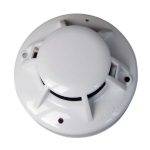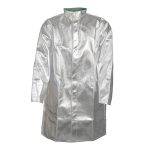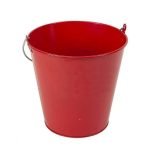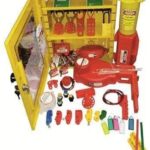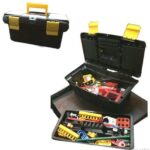Your list is empty, add products to the list to send a request
Fire Extinguisher Basics: Choosing the Right Type for Different Fires

25
Jul
In the realm of fire safety, understanding the various types of fire extinguishers and their appropriate uses is crucial. This comprehensive guide will explore the basics of fire extinguishers, helping you make informed decisions to protect your property and, most importantly, lives.
Understanding Fire Classes
Before delving into fire extinguisher types, it’s essential to understand the different classes of fires:
– Class A: Ordinary combustibles (wood, paper, cloth)
– Class B: Flammable liquids and gases
– Class C: Electrical fires
– Class D: Combustible metals
– Class K: Kitchen fires involving cooking oils and fats
Types of Fire Extinguishers
1. Water and Foam Extinguishers
Best for: Class A fires
The foam type fire extinguisher is effective for Class A fires and some Class B fires. It works by cooling the fire and creating a barrier between the fuel and oxygen.
2. Carbon Dioxide (CO2) Extinguishers
Best for: Class B and C fires
The fire extinguisher gas type, specifically CO2, is ideal for areas with sensitive electrical equipment as it leaves no residue.
3. Dry Chemical Extinguishers
Best for: Class A, B, and C fires
These versatile extinguishers are common in many settings. They work by interrupting the chemical reaction of the fire.
4. Wet Chemical Extinguishers
Best for: Class K fires
Often used as a kitchen fire extinguisher, these are specifically designed for commercial kitchens to combat cooking oil fires.
5. Clean Agent Extinguishers
Best for: Class A, B, and C fires
These use a gas that leaves no residue, making them ideal for areas with sensitive equipment.
6. Dry Powder Extinguishers
Best for: Class D fires
These are specifically designed for fires involving combustible metals.
Innovative Fire Extinguisher Designs
1. Fire Extinguisher Ball
The fire ball or elide fire ball is a innovative device that can be thrown into a fire, automatically activating and dispersing extinguishing agents.
2. Safe Pro Fire Extinguisher
This advanced extinguisher offers enhanced safety features and ease of use, making it an excellent choice for various environments.
Proper Storage and Maintenance
1. Fire Extinguisher Hanger Hook
Proper storage is crucial. Using a fire extinguisher hanger hook ensures the device is easily accessible and visible.
2. Regular Inspections
Check the pressure gauge regularly and ensure the safety pin is intact. The fire extinguisher cylinder should be free from dents or corrosion.
3. Professional Maintenance
Have your extinguishers professionally inspected annually and recharged or replaced as needed.
Additional Fire Safety Equipment
1. Hose Reel
A hose reel with a hose reel drum and hose reel pipes provides an additional layer of fire protection, especially in larger buildings.
2. Sprinkler Heads
Automatic sprinkler systems are crucial for larger spaces. The rosette plate around sprinkler heads ensures a neat and effective installation.
3. 4 Way Fire Brigade Inlet
This allows fire departments to supplement a building’s sprinkler or standpipe system with water from their trucks.
4. Emergency Exit Light
Proper illumination of exit routes is crucial during evacuations. Emergency exit lights guide people to safety in low visibility conditions.
5. Hooter Alarm
Fire hooters or hooter alarms provide audible warnings, alerting occupants to the presence of fire and the need to evacuate.
6. LPG Gas Leak Detector
Early detection of gas leaks can prevent fires before they start. An LPG gas leak detector is essential in areas where gas appliances are used.
Personal Protective Equipment (PPE) for Fire Safety
1. Footwear
Bata hunter shoes, atom safety shoes, and liberty police shoes provide protection against heat, falling objects, and slippery surfaces during fire emergencies.
2. Fire-Resistant Clothing
Agni suraksa clothing offers crucial protection for firefighters and individuals working in high-risk environments.
3. Armour
Specialized protective gear is essential for firefighters and emergency responders entering hazardous areas.
The Importance of Fire Safety Training
1. Proper Use of Extinguishers
Understanding how to use different types of extinguishers is crucial. The P.A.S.S. technique (Pull, Aim, Squeeze, Sweep) is a fundamental skill.
2. Evacuation Procedures
Regular fire drills help familiarize occupants with evacuation routes and procedures.
3. First Aid Training
Basic first aid knowledge can be crucial in fire emergencies.
Fire Prevention Strategies
1. Regular Risk Assessments
Identify potential fire hazards in your environment and address them proactively.
2. Electrical Safety
Ensure electrical systems are up to code and avoid overloading circuits.
3. Proper Storage of Flammable Materials
Store flammable liquids and gases in appropriate containers and areas.
4. No Smoking Policies
Implement and enforce no smoking policies in high-risk areas.
5. Regular Equipment Maintenance
Keep all equipment, especially heat-generating appliances, in good working order.
The Role of Technology in Fire Safety
1. Smart Smoke Detectors
These can send alerts to your phone and interconnect with other home systems.
2. Fire Safety Apps
Mobile apps can provide real-time evacuation instructions and emergency information.
3. Building Management Systems
Integrated systems can control HVAC, unlock doors, and manage other building functions during a fire.
Legal Requirements and Compliance
1. Building Codes
Ensure your fire safety equipment and procedures comply with local building codes.
2. Regular Inspections
Schedule and document regular inspections of all fire safety equipment.
3. Employee Training
In many jurisdictions, regular fire safety training for employees is a legal requirement.
Environmental Considerations in Fire Safety
1. Eco-Friendly Extinguishing Agents
Some modern extinguishers use agents that are less harmful to the environment.
2. Proper Disposal
Ensure old or used extinguishers are disposed of in an environmentally responsible manner.
3. Energy-Efficient Safety Equipment
Look for energy-efficient options in emergency lighting and alarm systems.
Special Considerations for Different Environments
1. Home Fire Safety
Focus on smoke detectors, easily accessible extinguishers, and clear evacuation plans.
2. Office Environments
Ensure proper coverage of different extinguisher types and regular staff training.
3. Industrial Settings
May require specialized extinguishers and more robust fire suppression systems.
4. Healthcare Facilities
Need careful planning for patient evacuation and protection of sensitive medical equipment.
5. Educational Institutions
Require clear evacuation procedures and age-appropriate fire safety education.
The Future of Fire Extinguisher Technology
1. IoT-Connected Devices
Future extinguishers may be able to alert emergency services automatically when used.
2. Improved Eco-Friendly Agents
Research is ongoing to develop more effective and environmentally friendly extinguishing agents.
3. Enhanced Usability
Developments in ergonomics and user interface design may make future extinguishers even easier to use under stress.
Creating a Comprehensive Fire Safety Plan
1. Risk Assessment
Identify potential fire hazards specific to your environment.
2. Equipment Selection
Choose appropriate fire extinguishers and safety equipment based on your risk assessment.
3. Placement Strategy
Strategically place extinguishers and safety equipment for quick access.
4. Training Program
Develop a comprehensive training program for all occupants.
5. Regular Drills
Conduct fire drills to test your plan and familiarize occupants with procedures.
6. Continuous Improvement
Regularly review and update your fire safety plan based on drills and any incidents.
The Psychological Aspect of Fire Safety
1. Overcoming Panic
Proper training helps individuals remain calm and act effectively in fire situations.
2. Building Confidence
Familiarity with fire safety equipment and procedures builds confidence in emergency response.
3. Creating a Safety Culture
Encourage a proactive approach to fire safety among all building occupants.
Conclusion
Understanding fire extinguisher basics and choosing the right type for different fires is a crucial aspect of comprehensive fire safety. From traditional extinguishers to innovative designs like the fire ball, and from personal protective equipment to advanced detection systems, a multi-faceted approach to fire safety is essential. Remember, the key to effective fire safety lies not just in having the right equipment, but in proper training, regular maintenance, and a proactive safety culture.
FAQs
1. Q: How often should I have my fire extinguishers inspected?
A: Firesupplies recommends monthly visual inspections and annual professional maintenance. However, always follow the manufacturer’s guidelines and local regulations.
2. Q: Can Firesupplies help me determine the right type and number of extinguishers for my property?
A: Absolutely! Firesupplies offers professional risk assessments and consultations to help you create a customized fire safety plan, including the selection and placement of appropriate extinguishers.
3. Q: What’s the difference between a fire ball and a traditional fire extinguisher?
A: While traditional extinguishers require manual operation, a fire ball from Firesupplies can be thrown into a fire, activating automatically. This can be particularly useful in hard-to-reach areas or for those with limited mobility.
4. Q: Does Firesupplies offer fire safety training programs?
A: Yes, Firesupplies provides comprehensive fire safety training programs, including proper use of extinguishers, evacuation procedures, and general fire prevention strategies.
5. Q: How do I dispose of an old or used fire extinguisher?
A: Firesupplies can assist with the proper disposal of old or used extinguishers. We offer environmentally responsible disposal services as part of our commitment to comprehensive fire safety solutions.
Don’t wait for a fire to strike before thinking about fire safety. At Firesupplies, we’re committed to providing you with the best fire safety solutions tailored to your specific needs. From top-quality fire extinguishers and innovative fire balls to comprehensive safety equipment and expert consultation, we have everything you need to protect what matters most. Our team of fire safety experts is ready to help you create a robust fire safety plan, select the right equipment, and provide the training you need to stay safe. Contact Firesupplies today for a free fire safety assessment and take the first step towards a safer environment. Remember, when it comes to fire safety, preparation is key – and Firesupplies is here to help you stay prepared for any situation.






